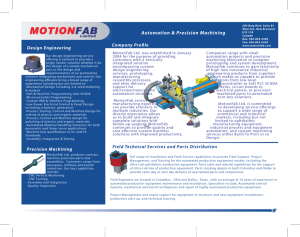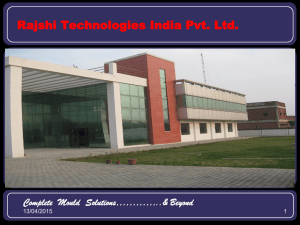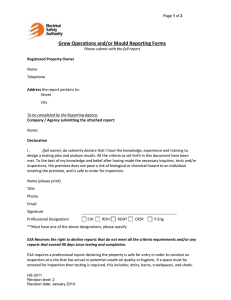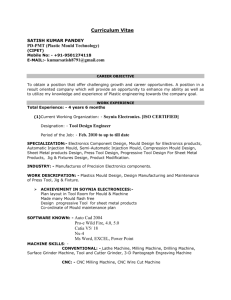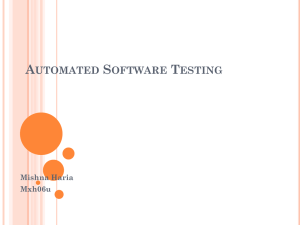Integrated Mould Manufacturing System in Digital Environment Dr. Rácz, Pál , Zafner, Gábor
advertisement
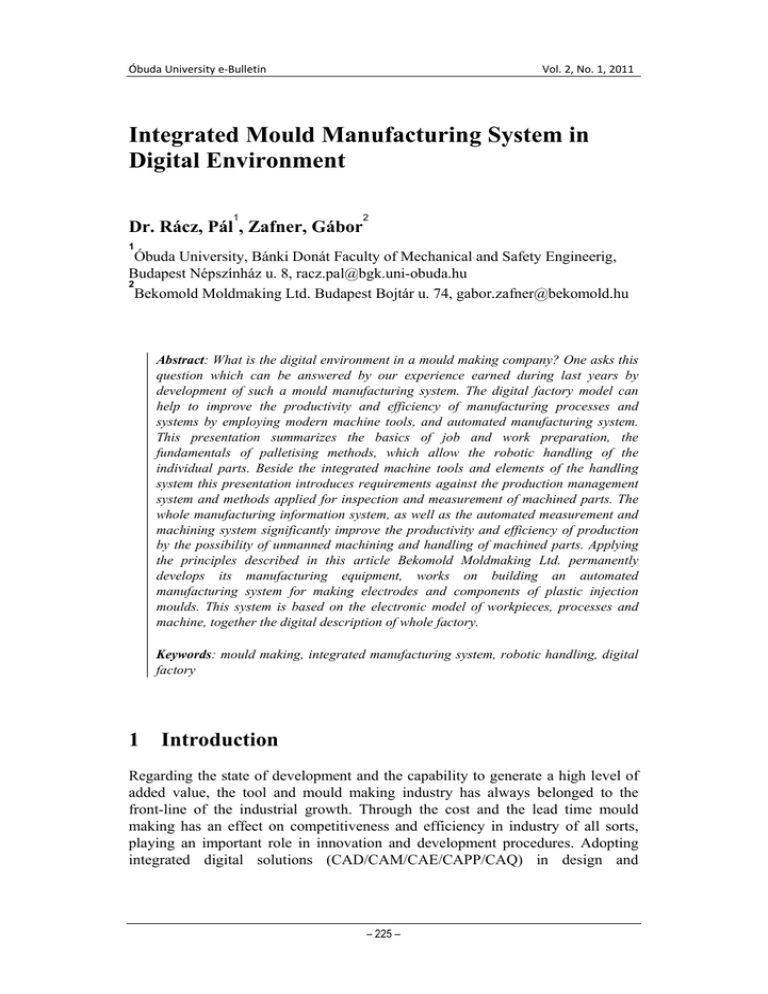
Óbuda University e‐Bulletin Vol. 2, No. 1, 2011 Integrated Mould Manufacturing System in Digital Environment 1 2 Dr. Rácz, Pál , Zafner, Gábor 1 Óbuda University, Bánki Donát Faculty of Mechanical and Safety Engineerig, Budapest Népszínház u. 8, racz.pal@bgk.uni-obuda.hu 2 Bekomold Moldmaking Ltd. Budapest Bojtár u. 74, gabor.zafner@bekomold.hu Abstract: What is the digital environment in a mould making company? One asks this question which can be answered by our experience earned during last years by development of such a mould manufacturing system. The digital factory model can help to improve the productivity and efficiency of manufacturing processes and systems by employing modern machine tools, and automated manufacturing system. This presentation summarizes the basics of job and work preparation, the fundamentals of palletising methods, which allow the robotic handling of the individual parts. Beside the integrated machine tools and elements of the handling system this presentation introduces requirements against the production management system and methods applied for inspection and measurement of machined parts. The whole manufacturing information system, as well as the automated measurement and machining system significantly improve the productivity and efficiency of production by the possibility of unmanned machining and handling of machined parts. Applying the principles described in this article Bekomold Moldmaking Ltd. permanently develops its manufacturing equipment, works on building an automated manufacturing system for making electrodes and components of plastic injection moulds. This system is based on the electronic model of workpieces, processes and machine, together the digital description of whole factory. Keywords: mould making, integrated manufacturing system, robotic handling, digital factory 1 Introduction Regarding the state of development and the capability to generate a high level of added value, the tool and mould making industry has always belonged to the front-line of the industrial growth. Through the cost and the lead time mould making has an effect on competitiveness and efficiency in industry of all sorts, playing an important role in innovation and development procedures. Adopting integrated digital solutions (CAD/CAM/CAE/CAPP/CAQ) in design and – 225 – P. Rácz et al. Integrated Mould Manufacturing System in Digital Environment manufacturing processes, the cost and the lead-time of mould making can be controlled and reduced. The basis of solutions are digitally specified design and manufacturing processes, electronic product specifications, manufacturing without a paper plot, integrating in-process and final inspection and measurement into the manufacturing process sequence, beside automation of manufacturing processes in the highest possible degree [1]. High-speed multi-axis processing, palletizing workpieces, automating workpiece- and tool-handling are giving opportunity to increase the productivity of mould making in such a digital environment. Needs of manpower within the confines of conventional mould making is very significant. Manpower needs can be moderated with the reduction of mid- and post-manufacturing interventions, thus for example measuring workpieces on cutting machine tools, changing electrode material from copper to graphite of EDM machines are such opportunities as can also help increasing productivity. 2 Basics of Manufacturing Automation There is a great number of preconditions to achieve the successful realization of automation projects. Without them the operation of the system can not be efficient enough. Within the inclusive costs of a project investment, the portion of the automation expenses can reach 30-50%, depending on whether the investment of the machine tools has already been realized or new machine tools have been purchased within the confines of the project. The machine tools involved in the project or purchased during the realization of the project shall have physical and electronic connectivity by which they can be connected to the automated handling system and to the IT system monitoring the whole manufacturing process. The key question to the success of the project is to organize and transform corporate processes and organization structure in a certain way that they can suit automation and support automated processes in order to maximize profit. With the increasing level of automation, fewer but more educated professionals are necessary, because the operators of the system are required to monitor simultaneously machining programs running on a number of machine tools. Regarding the training of professionals, the company shall have internal resources. The employees can gain the necessary specific knowledge during the installation and implementation phase of the machines and the system. Experience has proved that automation is not only possible at a mass production of manufacturing. The demand of rapid reactions to market needs requires flexibility and the elimination of the ever existing discrepancies in the system. The monitoring of the complete design and manufacturing procedure is significantly helping to handle discrepancies, although there is not a single system capable of solving every problem. [2] – 226 – Óbuda University e‐Bulletin Vol. 2, No. 1, 2011 The solution of automation projects requires close cooperation either from the mould makers’ and the machine and appliance manufacturer’s side. The integration of machines and equipment, in absence of standards, is a rather hard task, regarding both the physical connections of the system elements and the controlling software of the whole manufacturing system. A further important keystone and fundamental requirement to automated manufacturing is the application of tool and workpiece zero-point clamping and reference system (Fig. 1) [3]. By adopting zero-point reference systems, errors caused by the possible multiple discrete workpiece clamping and settings can be eliminated. Together with this productivity can be graded up notably, and setting work and time needs are decreasing. Zero-point reference systems can be realized by applying general purpose pallets, and in this way not only automated tool changing but automated workpiece changing is also possible. Fig. 1 Fig. 2 Zero-point clamping system by EROWA Measuring of offset values on a CMM The measuring of the offset values of palletized workpieces and cutting tools can be done on an external workplace on a CMM where setting up results can be assigned to pallet identifiers by software as well as all parameters and data of manufacturing (Fig. 2). The identification of a pallet and by this way the identification of workpieces is done by a handling robot with its attached reader device, with the help of an identifier chip mounted on the pallet. 3 Levels of Automation in Mouldmaking Several levels of automation are distinguished in mould making: • discrete machine automation; • two-machine with robotized handling system; – 227 – P. Rácz et al. Integrated Mould Manufacturing System in Digital Environment • integrated multi-machine system with robotized handling. Every single system raises similar problems during investing and operation. The more complicated they are the more organizational, IT and technological problems are required to be solved. By summarizing the unique characteristics of every single solution, these similarities and differences can be exposed. 3.1 Single Machine Automation By automated handling of single machines, every machine tool is handled by a dedicated manipulator, or a robot. Workpieces and tools are loaded on to the magazine racks of the handling unit by the operator. By the setting up of tools and workpieces especially, the offset values can be determined outside the machine. The NC programs of machining can be automatically downloaded from a central database and can be assigned to the in advance set workpieces. The manufacturing order of the placed in, palletized workpieces on the machine is determined by the operator, on the basis of the data retrieved from the production scheduling system. A completed workpiece, on a given machine, after carrying out inspection, can ideally go on to the next operation by the pallet on which it is clamped, although after manufacturing the workpiece is generally taken off the pallet. EDM electrodes machined on high speed milling machines can be exceptions as they are machined on the electrode holder as a clamping device. The automated handling of discrete machines is mostly applied at smaller enterprises, and only realized on a machine tool or two. 3.2 Machining Cells of Two Machines Automated cells of two-machine can be homogenous or mixed cells with one handling equipment (manipulator, robot). Homogeneous cells consist of machines of the same type, mostly sink EDM machines handled by a single robot. This solution can decrease investment costs, while a possible decrease in the number of operators can improve production efficiency. In mixed cells machine tools of different technology are handled by a single robot. Solutions like this can bring more benefit than homogenous cells. Efficiency grows considerably if both machines are used for the machining of a part, and between two machining operations the workpieces are not removed from the system. Most frequently high speed milling machines and sink EDM machines are integrated into one cell, where the machining of both the workpieces and the electrodes is possible without removing them from the cell. The duty of the operator staff working the cell is very similar to that of those at the single machine cell. One of the main tasks of the cell-controll is to monitor the load and the – 228 – Óbuda University e‐Bulletin Vol. 2, No. 1, 2011 utilization of the robot and to avoid overloading it [4]. Two-machine cells can be equally used in small- and medium-size batch production. Investment costs can be decreased especially by using homogenous two-machine cells compared to single machine systems. 3.3 Multi-Machine Manufacturing System The integrated multi-machine manufacturing system indicates a new level of quality in mould making. Although multi-machine automated manufacturing systems are very much flexible, still uniquely built up, since it has to conform to the demands of the mould maker, the variety of the machined parts, or rather the machine tool makers cannot offer solutions to everyone’s applications. The requirements of unique system build up needs are embracing modularity and through this the demand for the further development of the system. There has to be a loading station in the manufacturing system, where new workpieces are introduced into the system and completed workpieces are removed by the operator staff. Both by introducing in and removing at the loading station, the workpieces have to be identified for the system control software. Applying multi-axis combined machining comes into view in the integrated systems, as the loading of the handling robot can be decreased significantly. By decreasing the number of setting-ups positioning errors can be eliminated, as well as the need of manual intervention is going to be lower. In terms of two-machine cells, especially in case of integrated multi machine robot handled automated systems the question of inter operational inspection and inter operational intervention is to be raised, for example the problem of necessary cleaning and deburring. In case of bulk EDM electrodes the application of graphite electrodes can lead to an easygoing solution. There is no need of deburring by using graphite electrodes. The checking of fundamental dimensions can be done by measuring directly on the high speed milling machines. However, during the milling of mould parts burr formation is almost inevitable [5]. An individual decision is required if the burr makes the inspection measurement or further machining impossible on the milling-machine. In case of the necessity of manual cleaning, a deburring operation as well as an inspection measure has to be installed. Through loading station installed in the system the pieces separated for deburring and measuring can be removed or restored. A cleaning station operating by dry technology can be installed for cleaning where the burr chips from the manufactured pieces can be removed. After bulk EDM on an expediently developed station the dielectric can be distilled off the pieces before moving to their designated rack position. – 229 – P. Rácz et al. Integrated Mould Manufacturing System in Digital Environment Multi-machine systems are usually handled by one robot, that is, according to the prevalent solutions, moving on a linear track, between the machine tools and storing magazines placed one after the other (Fig. 3). Fig. 3 Robot on a linear track by EROWA Fig. 4 Fixed racks with robot grippers The linear track is mostly installed on the floor but gantry track solutions are also known. The robot moving on the track must be robust built, heavy-duty with cylindrical coordinate system or even six-axis, joint arm system. Since the robot has to handle several workpiece pallets and tools, its gripping device is always changeable and also has a chip reader. Storing magazines placed along the track can be various, as they have to receive electrodes, palletized workpieces, cutting tools. In favor of saving space the smaller devices can be stored in rotary magazines, while pallets of larger sizes can be placed onto fixed racks ( Fig. 4). 4 Digital Factory When it comes to automation in mould making, a digital factory described by an electronic model is what we are rather talking about. This is not a mass-produced automated cell, but a factory serving customer demands flexibly and quickly, where permanent feedback makes it possible to follow ever-changing demands through quick modifications, besides resulting in good machine utilization. Fig. 5 introduces such a process, the model of a digital factory. The principle is very simple. At first sight we could say “yes indeed, it is a modern ERP system”. If we carefully look around for solutions in the market, soon it comes to mind that the situation is more complicated. Our digital model – 230 – Óbuda University e‐Bulletin Vol. 2, No. 1, 2011 consists of blocks based on each other, components connected to each other, for which no program exists covering all, so we have to select all the appropriate components by ourselves. Fig. 5 Model of digital factory[6] If we take a robot-handled machine group placed along a linear track as a basis, it is obvious that a well-chosen hardware is only one element to the actuation of the process. System control software suitable for the processes has at least such an importance. This has to correspond with all the components of our digital model to ensure the control of the hardware. This is a fundamentally different approach from an automated machine addressing the handling unit waiting nearby to exchange workpieces. In an automated manufacturing system the conductor, namely the job management system: • is responsible for collecting the afore scheduled machining tasks; • overviews if everything is available for manufacturing; o the workpiece according to the pallet fixing plan; o appropriately set-up tools that are used in the NC program; – 231 – P. Rácz et al. Integrated Mould Manufacturing System in Digital Environment o as well as the offset values of the NC program coordinate system to the base coordinate system; • tracing the status of the workpiece; • monitoring of tools, registering the time spent in machining, taking out them from the system after expiration of their lifetime; giving orders to CNC machine to perform the next operation which is prepared, appropriate for all conditions, scheduled. As for the conductor: • it is required to be intelligent to overview the completion of the previous operation based on the operation schedule, to optimize the tasks, and to recognize if there is a discrepancy compared to the schedule; • also required to perform inspection measurements, in case of dimensional discrepancy to correct or to jump to the next scheduled task, and after eliminating the error causing discrepancy to continue the very task where the faulty dimension was detected; • it is also a duty to indicate if manufacturing is interrupted during machining. For the system to be able to take all this into account, a puffer is necessary which in case of possible error is capable of giving opportunity to our conductor to launch alternative tasks. Parts ordered to certain tasks can be traced by the help of an identification chip [7]. Also by the help of these, after completing any subtask it is possible to perform rescheduling that follows customer demands without losing control over the manufacturing deadline even for a moment. 5 Steps of the Manufacturing System Development Building up a multi machine robot handled integrated system is usually a result of a long developing process taking many years [8]. During this procedure the technological, organizational, programming and software knowledge indispensible for running such a system has to be acquired. Experiences show that afore taken steps, the problems to be solved are the following without a claim for completeness in a mould making company: • introduction of zero-point type workpiece pallet system; • setting up offset values outside machine tools on CMM; • introducing ERP system; • introducing pallet identification system; • electrode milling machine, bulk and wire EDM equipment with zero-point pallet clamping; • installing robotized bulk EDM cell; • organization of job preparing group, setting up robotized milling machine cell for making of EDM electrodes; – 232 – Óbuda University e‐Bulletin • • • • • • Vol. 2, No. 1, 2011 introducing PLM software; introduction of job management system; programmed, automated electrode and workpiece measuring; switching to graphite electrodes; introducing 4 and 5 axis electrode and workpiece milling; installing robot handled integrated manufacturing system consisting of three milling machines and a CMM for manufacturing electrodes and workpieces. Conclusions Automation and process integration has been forced by the continuously increasing customer demands and by the strong market competition. It requires a long time to prepare, develop and install an integrated manufacturing system in a mould making factory to produce electrodes and mould parts. One of the key elements of the system is the digital specification of the mould making factory described by an electronic model. This digital factory model consists of product, business and manufacturing system models working together with the job management system. Acknowledgement The research presented in this paper is co-financed by the University of Óbuda and Bekomould Mouldmaking Ltd. Budapest. References [1] G. Y. Kim, J. Y. Lee, H. S. Kang, S. D. Noh, Digital Factory Wizard: an integrated system for concurrent digital engineering in product lifecycle management, International Journal of Computer Integrated Manufacturing Vol. 23, Issue 11, pp. 1028-1045, ISSN: 0951-192X, Taylor and Francis 2010 [2] J. Nikbakhsh, A. Aydin, R. Javad, J. G. S. Mohammad , A multi-objective integrated cellular manufacturing systems design with dynamic system reconfiguration, International Journal of Advanced Manufacturing Technology (2011) 56, pp. 307-317, Springer 2011 [3] EROWA General Catalog 2008, Büron, Switzerland, 2008 [4] H. Nylund, P. H.Andersson, Simulation of service-oriented and distributed manufacturing systems, Robotics and Computer-Integrated Manufacturing 26 (2010) 622–628, Elsevier 2010 [5] J.C. Aurich, D. Dornfeld, P.J. Arrazola, V. Franke, L. Leitz, S. Min, Burrs – Analysis, control and removal, CIRP Annals - Manufacturing Technology, Vol. 58, Issue 2, 2009, pp. 519-542, Elsevier 2009 [6] Rácz P., Zafner G. Automated manufacturing system in mould making Factory Automation 2011 Conference, Győr, 2011. 05. 25-26., – 233 – P. Rácz et al. Integrated Mould Manufacturing System in Digital Environment Proceedings of Factory Automation 2011, Széchenyi István Egyetem, Győr 2011, pp. 80-88. ISBN 987-963-7175-3 [7] M. Stampfer, Automated setup and fixture planning system for box-shaped parts, International Journal of Advanced Manufacturing Technology (2009) 45: pp. 540–552, Springer 2009 [8] Chryssolouris, G., Mavrikios, D., Papakostas, N., Mourtzis, D., Michalos, G., Georgoulias, K. Digital manufacturing: history, perspectives, and outlook, Proceedings of the Institution of Mechanical Engineers Part BJournal of Engineering Manufacture Vol. 223, Issue 5, Special Issue: SI, pp. 451-462. May 2009 – 234 –
